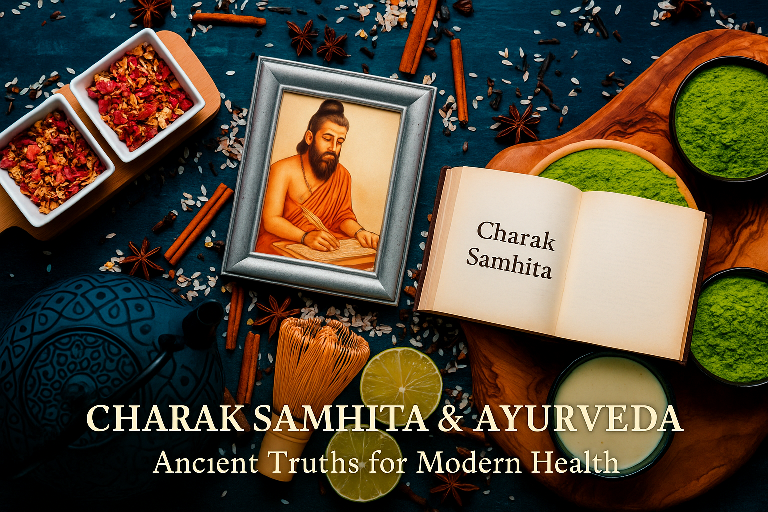Discover the Timeless Power of Charak Samhita and Ayurveda
Charak Samhita and Ayurveda form the ancient foundation of India’s traditional healthcare system. Rooted in holistic healing, these texts offer time-tested wisdom for physical, mental, and spiritual well-being. From dosha balance to herbal remedies, they emphasize natural living and disease prevention. Discover how Charak Samhita and Ayurveda still influence modern wellness worldwide.
Who Was Charaka and What is Charak Samhita?
Charaka was one of the most respected physicians and scholars in ancient India, widely recognized as the father of internal medicine in Ayurveda. He is believed to have lived between 100 BCE and 200 CE, during the reign of the Kushan Empire. According to historical accounts, Charaka served in the court of King Kanishka, a powerful emperor who supported learning and scholarly work across northern India.
Medical Knowledge Before Charaka
Before Charaka’s contributions, medical practices in India were rooted in spiritual rituals and oral traditions. Healing techniques were passed down through the Atharva Veda, which included incantations for treating ailments. These methods lacked clinical structure and scientific analysis.
It was the sage Agnivesha, under the guidance of Acharya Atreya, who first compiled Ayurveda in a structured form through the Agnivesha Tantra. Charaka later revised and expanded this foundational text, creating what we now refer to as the Charak Samhita.

What is Ayurveda?
Ayurveda, meaning “Science of Life” in Sanskrit, is one of the world’s oldest systems of natural healing. It is based on the principle that health is a balance between body, mind, spirit, and environment. Ayurveda emphasizes personalized care, prevention, and lifestyle optimization through diet, herbs, detoxification, yoga, and meditation.
Core concepts of Ayurveda include:
- Tridosha Theory: Vata (air), Pitta (fire), and Kapha (earth/water) must be balanced.
- Agni (Digestive Fire): Central to good health and disease prevention.
- Prakriti: Each individual has a unique body-mind constitution.
- Ama (Toxins): Disease is caused by the buildup of toxins.
- Dinacharya & Ritucharya: Daily and seasonal health routines.
- Ojas: Vital energy responsible for immunity and vitality.
Charak Samhita and Ayurveda together emphasize the root cause of disease rather than symptom management, making them highly relevant even today.
Structure of Charak Samhita
The Charak Samhita is divided into eight comprehensive sections (Sthanas) with 120 chapters. Each section focuses on a unique aspect of medicine:
- Sutra Sthana – Basic principles
- Nidana Sthana – Diagnosis of diseases
- Vimana Sthana – Evaluation of patients and treatments
- Sharira Sthana – Anatomy and physiology
- Indriya Sthana – Prognostics and clinical signs
- Chikitsa Sthana – Therapeutics and disease management
- Kalpa Sthana – Formulations and detox techniques
- Siddhi Sthana – Case studies and treatment outcomes
These sections showcase the depth of clinical understanding Charaka developed centuries before modern medicine.
How Ayurveda Works in Modern Healthcare
In today’s world, Ayurveda is gaining global recognition for its preventive, holistic, and patient-centered approach. Here’s how Charak Samhita and Ayurveda remain useful in modern healthcare:
- Personalized Wellness: Unlike generic treatments, Ayurveda tailors therapy to the patient’s unique constitution (Prakriti).
- Preventive Focus: Emphasizes prevention through seasonal routines, detox, and dietary planning.
- Stress and Mental Health: Ayurvedic herbs like Brahmi, Ashwagandha, and lifestyle practices like meditation help reduce anxiety and improve mental clarity.
- Chronic Disease Management: Effective in managing conditions like arthritis, diabetes, IBS, and migraines through long-term natural therapies.
- Global Integration: Recognized by WHO, used in wellness resorts, integrative hospitals, and nutritional therapy centers worldwide.
- Immunity Boosting: Especially during COVID-19 and post-pandemic, Ayurveda’s Rasayana therapy and herbal immunity boosters have gained immense popularity.
Modern science is also validating many ancient Ayurvedic formulations and practices, proving the wisdom of Charak Samhita and Ayurveda remains timeless and therapeutically effective.
10 Amazing Truths of Charak Samhita and Ayurveda
1. Foundation of Internal Medicine
Charak Samhita and Ayurveda laid the foundation of internal medicine centuries ago. The text provides a detailed methodology for diagnosing and treating a wide variety of diseases—well before the emergence of modern medical sciences. Charaka’s scientific insights into human physiology, pathology, and pharmacology are still taught in Ayurvedic medical colleges today, making it one of the oldest surviving medical systems.
2. A Holistic View of Life and Health
Unlike conventional medicine, Charak Samhita and Ayurveda treat the human being as a whole—mind, body, and soul. It considers health as a dynamic balance of physical function, mental peace, spiritual awareness, and harmony with nature. Diseases are viewed as imbalances rather than isolated problems, allowing for deeper healing through customized treatments, lifestyle routines, and mental wellness.
3. The Tridosha Principle
One of the core concepts in Charak Samhita and Ayurveda is the Tridosha theory—Vata, Pitta, and Kapha.
- Vata represents air and space, governing movement, breathing, and nerve impulses.
- Pitta symbolizes fire and water, controlling digestion, metabolism, and energy production.
- Kapha is a combination of earth and water, providing structure, lubrication, and immunity.
Every individual has a unique doshic balance (Prakriti). Illness arises when any of the doshas go out of balance. Treatment involves restoring harmony using herbs, diet, yoga, and lifestyle modifications customized to one’s constitution.
4. Personalized and Preventive Medicine
Thousands of years before modern medicine introduced “personalized care,” Charak Samhita and Ayurveda already used this principle. Treatments were tailored based on body type, season, mental tendencies, age, and environment. Seasonal regimens (Ritucharya), daily routines (Dinacharya), and dietary guidelines are prescribed to prevent illness and maintain optimal health.
5. Food is Your First Medicine
According to Charak Samhita and Ayurveda, food is the primary source of healing. The effect of food on health depends on its taste, energy, post-digestive effect, and compatibility with an individual’s dosha. A balanced diet enhances Agni (digestive fire), eliminates Ama (toxins), and strengthens immunity. Charaka classified food into multiple categories based on its therapeutic properties—long before the discovery of vitamins or proteins.
6. Emotional and Mental Health
Mental health holds equal importance in Charak Samhita and Ayurveda. Emotions like fear, anger, jealousy, and grief are recognized as causes of physical ailments. Charaka emphasized cultivating a stable and pure mind (Sattva) through meditation, truthful speech, non-violence, and ethical conduct. This mind-body connection, now validated by modern psychiatry, was clearly articulated thousands of years ago.
7. Potent Herbal Remedies
Herbs are central to healing in Charak Samhita and Ayurveda. The text includes thousands of plant-based remedies, each classified by taste, potency, digestive action, and impact on doshas. Famous herbs like Ashwagandha (for strength), Brahmi (for mental clarity), and Triphala (for detoxification) remain widely used today. Many of these herbs are now under clinical trials for their anti-inflammatory, adaptogenic, and neuroprotective effects.
🔗 Learn more: Ministry of AYUSH – Ayurveda Portal
8. Knowledge of Epidemics and Environmental Health
Charak Samhita and Ayurveda even explored concepts related to public health. The term Janapadodhwamsa describes how environmental factors—polluted air, contaminated water, seasonal changes—can cause widespread diseases. Charaka recommended detox, community hygiene, and seasonal balancing to manage epidemics, much like modern approaches to environmental medicine and pandemic control.
9. Relevance in Modern Wellness Trends
The global wellness industry is rediscovering what Charak Samhita and Ayurveda taught thousands of years ago. Practices like detox, mindful eating, yoga, herbal therapy, and dosha-based diets are now seen as part of integrative health strategies. From spas to nutrition coaching, Ayurvedic wisdom is influencing fitness, mental health, and longevity solutions worldwide.
🔗 WHO Report: WHO Global Report on Traditional Medicine 2023
10. A Path to Natural Living
At its core, Charak Samhita and Ayurveda promote a life of simplicity, self-awareness, and harmony with nature. Health isn’t something to be “fixed” but something to be maintained through wise daily habits, clean food, rest, spiritual balance, and seasonal awareness. This natural living approach not only heals but prevents the root causes of disease in a sustainable way.
Frequently Asked Questions (FAQ)
What is Charak Samhita?
Charak Samhita is a foundational Ayurvedic text that outlines internal medicine practices. It emphasizes personalized treatment, diet, and holistic healing strategies aligned with the principles of Ayurveda.
How does Ayurveda differ from modern medicine?
Unlike modern symptom-based treatments, Ayurveda—as guided by texts like Charak Samhita—focuses on identifying the root cause through dosha analysis, lifestyle, and diet corrections to ensure long-term balance and prevention.
Can I integrate Ayurvedic principles into daily life?
Absolutely. Charak Samhita and Ayurveda recommend daily routines like tongue scraping, oil pulling, yoga, and herbal remedies tailored to your body constitution (Prakriti) for natural, sustainable wellness.
Conclusion: Why Charak Samhita and Ayurveda Still Matter Today
Charak Samhita and Ayurveda offer far more than historical value—they provide a timeless, holistic framework for living in harmony with nature and oneself. In an age of rising chronic illnesses and lifestyle disorders, revisiting these ancient principles can empower us to reclaim balance, prevent disease, and nurture long-term vitality. By aligning with Ayurvedic wisdom, we don’t just treat illness—we cultivate a way of life that promotes physical, mental, and spiritual well-being.
To explore modern Ayurvedic research, visit the Ministry of AYUSH official portal.
To explore related insights, check out:

